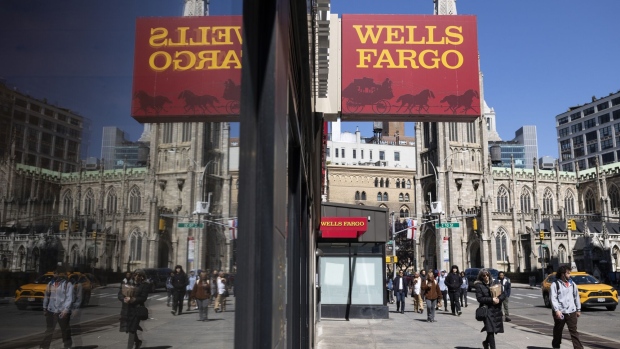Apr 14, 2023
Wells Fargo’s Net Interest Income Beats Estimates on Fed Hikes
, Bloomberg News

(Bloomberg) -- Wells Fargo & Co. reported higher-than-expected net interest income in the first quarter as the firm continued to reap the gains of the Federal Reserve’s rate hikes.
The firm had $13.3 billion in NII in the first three months of year, up 45% from a year earlier and more than the 42% jump analysts expected, Wells Fargo said in a statement. That helped counter a surge in provisions for souring loans, leaving profit to top analysts’ estimates.
Wells Fargo and peers JPMorgan Chase & Co. and Citigroup Inc. are kicking off big bank earnings Friday, offering a first look at how lenders fared through a tumultuous quarter in which three smaller banks collapsed. PNC Financial Services Group Inc. also reported Friday, the first results for regional firms.
All four of those companies were part of a group of 11 banks that helped shore up ailing First Republic Bank with a combined $30 billion deposit infusion as it faced panic in the wake of Silicon Valley Bank’s failure. Wells Fargo contributed $5 billion to the effort, which involves each firm parking money at First Republic for at least 120 days.
“We are glad to have been in a strong position to help support the US financial system during the recent events that impacted the banking industry,” Chief Executive Officer Charlie Scharf said in the statement. “Regional and community banks are an important part of our financial system and are uniquely positioned to serve their customers and communities.”
The San Francisco-based company left full-year guidance for both net interest income and non-interest expenses unchanged.
Wells Fargo shares rose 1.1% to $40.10 at 9:55 a.m. in New York. They’ve dropped 2.9% this year.
The firm added $643 million to its pile of money set aside for potentially soured loans, signaling a worsened economic outlook. Net charge-offs jumped 17% compared to a year ago, bringing total provisions to $1.2 billion, topping the $919 million average of analyst estimates compiled by Bloomberg.
The increase in reserves was primarily tied to the firm’s office loans inside its commercial real estate portfolio, Wells Fargo said. It also added reserves for credit-card and auto loans in the quarter.
In recent months, investors have become increasingly worried about commercial real estate credit quality, with large swaths of offices sitting empty in major metropolitan areas across the country in the aftermath of the pandemic. Wells Fargo said that roughly 12% of its office loan portfolio is owner-occupied, and nearly one-third have recourse to a guarantor.
The company reported an 8% drop in firmwide deposits, noting the the decline was fueled by customers migrating to higher-yielding alternatives and an increase in consumer spending. Average deposit costs soared to 83 basis points compared with just 3 basis points a year ago.
Expenses, a key focus of Scharf’s turnaround effort, totaled $13.7 billion, slightly higher than analysts expected. That helped bring Wells Fargo’s efficiency ratio, a measure of profitability, to 66%.
Wells Fargo remains under a Federal Reserve-imposed asset cap limiting the size to an end-of-2017 level. Assets at the end of the first quarter totaled $1.86 trillion, lower than a year earlier.
(Updates with shares in seventh paragraph.)
©2023 Bloomberg L.P.






